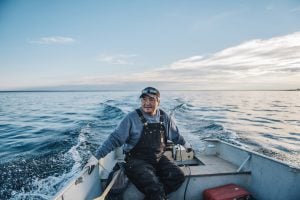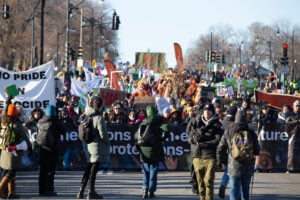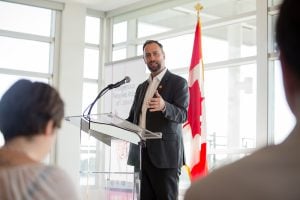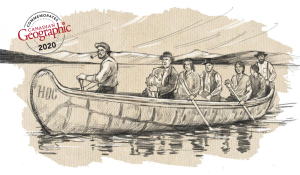
Environment
Inside the fight to protect the Arctic’s “Water Heart”
How the Sahtuto’ine Dene of Déline created the Tsá Tué Biosphere Reserve, the world’s first such UNESCO site managed by an Indigenous community
- 1693 words
- 7 minutes
This article is over 5 years old and may contain outdated information.
People & Culture

On a bright September day in 2013, I found myself on stage in a huge room at the Pacific National Exhibition in Vancouver. In my hands was a copy of They Called Me Number One: Secrets and Survival at an Indian Residential School, my 2013 memoir of the three generations of women in my family — my grandmother, my mother and me — who had attended a residential school, a physically and psychologically painful experience many other former students are still trying to get over.
I was in Vancouver for a Truth and Reconciliation Commission national event, one of seven that the commission held across the country to engage and educate the public about the history of residential schools. Marie Wilson, one of the commission’s three commissioners, had invited me there to place my book into a sacred bentwood box, a symbolic gesture meant to commemorate personal journeys toward healing and reconciliation between Indigenous and non-Indigenous peoples. Thousands of items from across the country — a Saskatoon Police Service hat, beaded moccasins, a prayer shawl, a suitcase, to name but a few — would eventually be placed in the box, which Luke Marston, a Coast Salish artist, had constructed from a single piece of red cedar and carved to represent First Nations, Inuit and Métis cultures.
I spoke for about three minutes before I put my book in the box, but I didn’t tell any personal stories. Writing privately about some of my experiences at St. Joseph’s Mission School in Williams Lake, B.C., which I attended between the ages of seven and 12, and allowing myself the tears of remembering was easier than talking in front of others about some of the things that had happened to me. I didn’t feel strong enough to share that way, even though I always encourage former residential school students to tell their stories. And yet I’ll probably take some of my stories and memories to my grave.
During the Vancouver event, however, I did attend some of the sharing sessions, watching as former students made statements about their experiences. I thought about how brave they were to do so. They told their stories, and those who wanted to learn about the residential school system and its legacy, Indigenous and non-Indigenous alike, were able to bear witness. The Truth and Reconciliation Commission made that possible.

When I first heard about the commission in 2008, I wanted to be a part of it. I knew the importance of getting this part of the country’s history out to Canadians, many of whom did not understand or know what had happened in these schools.
I applied to become one of the commission’s commissioners and was unsuccessful, but I kept my ear to the ground on what was happening. I wondered what the public reaction to the commission would be once it started its work. I was wary because my own experience with publicity about residential schools had not been a good one.
In 1987, during my first term as one of the chiefs of British Columbia’s Cariboo Tribal Council (now known as the Northern Shuswap Tribal Council), we were doing work on why the four First Nations that make up our community had so many social problems, such as family breakdown, substance abuse and suicide. At the time, we didn’t realize how traumatic events could leave a lasting impression. Once we started to examine these problems closely, though, it seemed that all roads led back to the residential schools. With that in mind, our council asked Roland Chrisjohn, at the time an associate professor of psychology at the University of Guelph, to conduct a study of former residential school students. The results, which were outlined in a 1991 Canadian Journal of Native Education article titled “Faith Misplaced: Lasting Effects of Abuse in a First Nations Community,” helped make sense of the social conditions we were facing. It was then that we started to look for ways to overcome the destructive conditioning we had received at residential schools.
Because the tribal council, Chrisjohn and the University of Guelph had issued a news release about the study, the community started to garner media attention. Reluctantly, I stepped forward to act as the council’s spokesperson on the study. Suddenly, I found myself on the front page of national newspapers and being interviewed by television crews. The CBC’s Fifth Estate did a documentary on St. Joseph’s Mission School. It was overwhelming at the time, but I answered questions and was very open and honest about what had happened — how children were separated from their parents and community, how we were required to do physical labour, how we endured physical and mental abuse at the hands of school staff, how we were indoctrinated in foreign religious beliefs.
It was during this period that I started to receive hate mail. How dare we accuse the churches of these acts? How dare we not be thankful that we received an education from the schools? How dare we complain after all that Canada does for us? I was absolutely horrified to receive these letters, and I threw them into my wood stove, hoping the extremely ugly thoughts they contained would disappear along with the paper they were written on. I did not receive one letter of support or empathy.
Perhaps I shouldn’t have been surprised. When my non-Indigenous friend, Elizabeth Furniss, published her book Victims of Benevolence: The Dark Legacy of the Williams Lake Residential School in 1995, I was shocked when she told me that that no one in Williams Lake would agree to sell the book in their store. In 1994 or 1995, the subject of residential schools was raised in one of my university history classes. A young white woman was visibly shaken when the subject was brought up. She insisted that the churches would not commit the acts that had occurred in the schools. While she did not say it outright, she indicated that she believed these were lies being told about the churches. At the time, I was still unable to speak about the abuses, so I remained silent.
I was amazed that the commission’s 2013 Vancouver event was being held at the Pacific National Exhibition grounds, a venue that seemed unnecessarily huge. I honestly didn’t believe that anyone but former residential school students and their families would be interested in attending.
But as I walked around the grounds, I saw so many people, most of them non-Indigenous. During the event, the filmmaker Lisa Jackson was premiering Hidden Legacies, her documentary about how residential schools continue to affect the generation of Indigenous children who did not attend the schools. My daughter, Jacinda Mack, and I are in the film and had been invited to speak after the screening. There must have been 2,500 people in the room, including a busload of students who had come all the way from Oregon, and again most of them were non-Indigenous. Question after question was asked after we spoke, and I think people were upset when scheduling dictated that the session finally had to be closed. I was so pleased with the turnout and the diversity of the people who attended the screening and question-and-answer session.
Yet despite being glad that events such as the one in Vancouver were taking place, being there still brought home to me the injustice of the residential school system.

One day, word spread that the churches attending the event had pictures of former students. They were set up in the corner of a building where you could sit down and go through the albums and get a photocopy of the picture you wanted. It seemed like everyone who had attended a residential school in British Columbia made their way to that corner to see what they could find.
My mom was with me when I found a picture of my brother Bobby, who had also attended St. Joseph’s Mission school but had died in 1971. He’d disappeared one day and a month later his body was found at the bottom of a cliff. We’ll never know if his death was an accident or a suicide. Bobby was 18 when he died, but the school picture I found was taken when he was about eight. I wasn’t sure whether to show the picture to my mom because I didn’t know if it would really upset her to see him as a young boy after all the years that had passed. Imagine what that would be like — a parent in her 80s being able to see for the first time a picture of her child during his school years. Most parents have all kinds of pictures of their kids growing up. Not my mom.
As we combed through each album trying to find a remnant of our time spent at the school, I wondered why the schools could not have shared these pictures with parents at the time they were taken. It angered me to think of the sadness and pain that a picture can bring back.
I finally did show Bobby’s picture to mom, and she was sad but also appreciative that the church had shared the images. I became upset with her because she felt they were doing us a favour. The bigger picture seemed to escape her. In the end, I let it go. I was glad the pictures were made available. We might never have known they existed if the commission hadn’t been put in place.

By the time the commission published its final report in December 2015, it had received more than 6,750 statements from survivors of residential schools, their families and other people who shared their knowledge of the system and its legacy. Countless more had attended the national events, opening themselves to hearing about the residential school experience.
But how far have we moved along that path of healing and reconciliation that the bentwood box I put my book into represented?
When my book came out, I fully expected to get the kind of hate mail I had received previously. I warned my family about this, telling them to make sure that my granddaughters, who appear on the book’s front cover, were shielded from any comments. But I needn’t have done so. To my amazement, I have not received one negative remark since publishing my book and going out to speak. No nasty phone calls. No cruel emails or handwritten letters. No hurtful comments.
What does this tell me? That Canadian society is maturing. That Canadians are willing to listen. That Canadians can acknowledge the crimes committed, the racist laws that existed and the oppression that occurred in a freedom-loving country such as Canada. That the “truth” in the commission’s title is coming out.
The “reconciliation” part, however, might be a bit tricky.
The Canadian government has been trying to reconcile with Indigenous Peoples for a long time, through bodies such as the Royal Commission on Aboriginal Peoples. About $60 million was spent on that commission, but the lives of those for whom it was established never changed because its recommendations were never fully acted upon.
Will the Truth and Reconciliation Commission be different? Will all 94 of the “calls to action” in its final report be fulfilled and, as the commission puts it, “advance the process of reconciliation”? I hope so. But I also hope that even before that happens, Indigenous Peoples can regain control of their own lives and fates, and that we are not told how to live those lives. And I think that can happen if governments realize that the shaping of this country into one we all could be proud of would have been — and can still be — better with the help of Indigenous voices.
Are you passionate about Canadian geography?
You can support Canadian Geographic in 3 ways:

Environment
How the Sahtuto’ine Dene of Déline created the Tsá Tué Biosphere Reserve, the world’s first such UNESCO site managed by an Indigenous community

People & Culture
Indigenous knowledge allowed ecosystems to thrive for millennia — and now it’s finally being recognized as integral in solving the world’s biodiversity crisis. What part did it play in COP15?

People & Culture
The director of the National Centre for Truth and Reconciliation reflects on Indigenous progress in 2017 and looks ahead to 2067

History
A look back at the early years of the 350-year-old institution that once claimed a vast portion of the globe